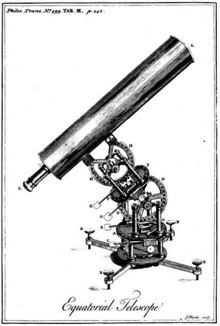James Short

James Short (born June 10, 1710 in Edinburgh , Scotland , † July 14, 1768 in London ) was a British mathematician , optician and telescope builder .
Orphaned at an early age, he entered the Royal High School and in 1726 the University of Edinburgh to study theology. Here, however, Colin Maclaurin (1698–1746), professor of mathematics, became aware of Short and encouraged him to specialize in the manufacture of telescope mirrors . From 1732 Mac Laurin gave him his rooms for optical experiments and the construction of mirror telescopes .
Master of telescope construction
Short wanted to improve the Gregory telescope type and initially still used glass for the mirrors, as James Gregory had recommended at the time. Later - and after exchanging experiences with John Mudge (1721–1793) - he only used metal mirrors that were then made of speculum , a copper-tin alloy. As a result, he finally succeeded in grinding the main mirror precisely as a paraboloid and the secondary mirror as an ellipsoid . The high image sharpness of its products soon made them known throughout Europe; he built almost 1400 telescopes, 110 of which have survived to this day.
His large 18-inch Gregory for the Spanish King (1752) became famous. Most of his smaller mirrors had focal ratios between 1: 4 and 1: 6 and focal lengths of 6 to 12 feet. A 9-inch Newtonian telescope with 1: 8 for the Greenwich Observatory was later surpassed by a similar instrument from Herschel.
When he became a Fellow of the Royal Society , he settled in London in 1738. In 1753 he graduated from the prestigious St. Andrews University and founded the Edinburgh Philosophical Society here . In 1757 the Royal Swedish Academy of Sciences appointed him a corresponding member . At the end of his life († 1768 in London) Short could look back on a remarkable professional career.
Astronomical work
Through many observations, Short communicated with the Royal Society, u. a. to auroras , eclipses and star coverages . In 1740 he saw a moon of Venus in the same light phase as the planet, but this remained a mystery. From his measurements of the passage of Venus in 1761 and others from Europe and South Africa, he calculated the solar parallax to be 8.65 ", which was long considered a reference. From four Mercury transits he determined the astronomical difference in length between Greenwich and Paris. A new type of equatorial can also be traced back to him.
In his honor, the short moon crater was named after him.
Short observatory
In 1776 James' brother Thomas Short returned to Edinburgh and brought his large, 12-foot reflector telescope (3.7 m focal length) with him to set up a commercial observatory. It turned out differently, however: In 1736 the Edinburgh mathematician and geodesist Colin Maclaurin raised money for a university observatory. As a result of the Jacobite uprising in 1745, the funds remained unused and have now been released for an observatory building on Calton Hill in the city.
The Short Observatory was built by James Craig as a classical fortress and became the first observatory building of the later City Observatory . For financial reasons, only the first of the planned towers was built. Thomas Short lived and directed the observatory until his death in 1788. Later, a second observatory was built in the area of the current Playfair Building.
Web links
| personal data | |
|---|---|
| SURNAME | Short, James |
| BRIEF DESCRIPTION | British mathematician, optician and telescope builder |
| DATE OF BIRTH | June 10, 1710 |
| PLACE OF BIRTH | Edinburgh , Scotland |
| DATE OF DEATH | July 14, 1768 |
| Place of death | London |
